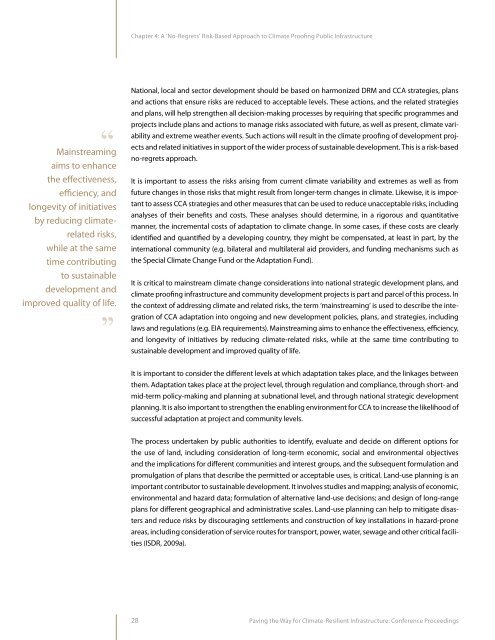Paving the Way for Climate-Resilient Infrastructure - UN CC:Learn
Paving the Way for Climate-Resilient Infrastructure - UN CC:Learn
Paving the Way for Climate-Resilient Infrastructure - UN CC:Learn
You also want an ePaper? Increase the reach of your titles
YUMPU automatically turns print PDFs into web optimized ePapers that Google loves.
Chapter 4: A ‘No-Regrets’ Risk-Based Approach to <strong>Climate</strong> Proofing Public <strong>Infrastructure</strong>‘‘Mainstreamingaims to enhance<strong>the</strong> effectiveness,efficiency, andlongevity of initiativesby reducing climaterelatedrisks,while at <strong>the</strong> sametime contributingto sustainabledevelopment andimproved quality of life.’’National, local and sector development should be based on harmonized DRM and <strong>CC</strong>A strategies, plansand actions that ensure risks are reduced to acceptable levels. These actions, and <strong>the</strong> related strategiesand plans, will help streng<strong>the</strong>n all decision-making processes by requiring that specific programmes andprojects include plans and actions to manage risks associated with future, as well as present, climate variabilityand extreme wea<strong>the</strong>r events. Such actions will result in <strong>the</strong> climate proofing of development projectsand related initiatives in support of <strong>the</strong> wider process of sustainable development. This is a risk-basedno-regrets approach.It is important to assess <strong>the</strong> risks arising from current climate variability and extremes as well as fromfuture changes in those risks that might result from longer-term changes in climate. Likewise, it is importantto assess <strong>CC</strong>A strategies and o<strong>the</strong>r measures that can be used to reduce unacceptable risks, includinganalyses of <strong>the</strong>ir benefits and costs. These analyses should determine, in a rigorous and quantitativemanner, <strong>the</strong> incremental costs of adaptation to climate change. In some cases, if <strong>the</strong>se costs are clearlyidentified and quantified by a developing country, <strong>the</strong>y might be compensated, at least in part, by <strong>the</strong>international community (e.g. bilateral and multilateral aid providers, and funding mechanisms such as<strong>the</strong> Special <strong>Climate</strong> Change Fund or <strong>the</strong> Adaptation Fund).It is critical to mainstream climate change considerations into national strategic development plans, andclimate proofing infrastructure and community development projects is part and parcel of this process. In<strong>the</strong> context of addressing climate and related risks, <strong>the</strong> term ‘mainstreaming’ is used to describe <strong>the</strong> integrationof <strong>CC</strong>A adaptation into ongoing and new development policies, plans, and strategies, includinglaws and regulations (e.g. EIA requirements). Mainstreaming aims to enhance <strong>the</strong> effectiveness, efficiency,and longevity of initiatives by reducing climate-related risks, while at <strong>the</strong> same time contributing tosustainable development and improved quality of life.It is important to consider <strong>the</strong> different levels at which adaptation takes place, and <strong>the</strong> linkages between<strong>the</strong>m. Adaptation takes place at <strong>the</strong> project level, through regulation and compliance, through short- andmid-term policy-making and planning at subnational level, and through national strategic developmentplanning. It is also important to streng<strong>the</strong>n <strong>the</strong> enabling environment <strong>for</strong> <strong>CC</strong>A to increase <strong>the</strong> likelihood ofsuccessful adaptation at project and community levels.The process undertaken by public authorities to identify, evaluate and decide on different options <strong>for</strong><strong>the</strong> use of land, including consideration of long-term economic, social and environmental objectivesand <strong>the</strong> implications <strong>for</strong> different communities and interest groups, and <strong>the</strong> subsequent <strong>for</strong>mulation andpromulgation of plans that describe <strong>the</strong> permitted or acceptable uses, is critical. Land-use planning is animportant contributor to sustainable development. It involves studies and mapping; analysis of economic,environmental and hazard data; <strong>for</strong>mulation of alternative land-use decisions; and design of long-rangeplans <strong>for</strong> different geographical and administrative scales. Land-use planning can help to mitigate disastersand reduce risks by discouraging settlements and construction of key installations in hazard-proneareas, including consideration of service routes <strong>for</strong> transport, power, water, sewage and o<strong>the</strong>r critical facilities(ISDR, 2009a).28<strong>Paving</strong> <strong>the</strong> <strong>Way</strong> <strong>for</strong> <strong>Climate</strong>-<strong>Resilient</strong> <strong>Infrastructure</strong>: Conference Proceedings
















